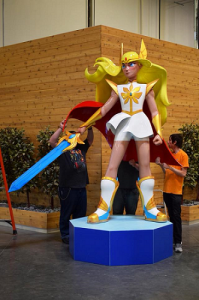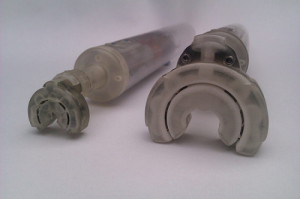It’s business news as usual to kick things off in today’s 3D Printing News Briefs, and then we’re moving on to a little medical and metal 3D printing news, followed by a 3D printing experiment and a superhero-sized 3D printed statue. The LEHVOSS Group is expanding the production capacities for its LUVOCOM material, DyeMansion has announced that its new RAL colors are now available, and the Million Waves Project receives a large grant from Shell Oil. A medical technology company is using HP’s Multi Jet Fusion to 3D print dental aligners, a YouTube video shows the depowdering process for a metal 3D printed turbine, and an experiment shows if it’s possible to use a DLP 3D printer for PCB etching. Finally, WhiteClouds designed and 3D printed a huge statue of She-Ra for a special event.
LEHVOSS Group Expanding LUVOCOM Production Capacity
 Not long ago, the LEHVOSS Group, which operates under the management of parent company Lehmann&Voss&Co., revealed that that it would be showcasing its high-performance, thermoplastic LUVOCOM 3F 3D printing compounds at upcoming trade shows. Now, in order to keep meeting the ever increasing demand for these materials, the company has taken important steps, such as constructing a new laboratory and innovation center in Hamburg and commissioning an additional compounding line, to expand the worldwide production capacities for LUVOCOM.
Not long ago, the LEHVOSS Group, which operates under the management of parent company Lehmann&Voss&Co., revealed that that it would be showcasing its high-performance, thermoplastic LUVOCOM 3F 3D printing compounds at upcoming trade shows. Now, in order to keep meeting the ever increasing demand for these materials, the company has taken important steps, such as constructing a new laboratory and innovation center in Hamburg and commissioning an additional compounding line, to expand the worldwide production capacities for LUVOCOM.
“At the same time, these investments are just another consistent step within the framework of our long-term growth strategy,” said Dr. Thomas Oehmichen, a shareholder of Lehmann&Voss&Co. with personal liability. “Additional extensive investments in the expansion of our plastics business are currently the subject of detailed planning and are set to follow shortly.”
DyeMansion’s New RAL Colors Available
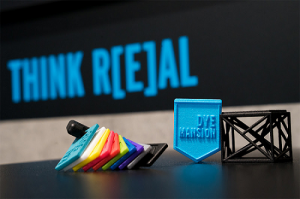 While attending the TCT Show in Birmingham recently, DyeMansion launched three machines that work together to depowder, surface treat, and dye 3D printed parts. The DM60 is the fully automated dyeing part of the system, and the company added a brand new palette of 170 standard RAL colors for PA2200 to its portfolio to let people expand the color range of the system significantly.
While attending the TCT Show in Birmingham recently, DyeMansion launched three machines that work together to depowder, surface treat, and dye 3D printed parts. The DM60 is the fully automated dyeing part of the system, and the company added a brand new palette of 170 standard RAL colors for PA2200 to its portfolio to let people expand the color range of the system significantly.
DyeMansion has now announced that its new RAL colors for the PolyShot Surfacing (PSS) finish are now available for DM60 color cartridges, and can be ordered via the DyeMansion On-Demand Service. To check if your favorite colors are available, type in the RAL color code on the website. To learn more about the RAL palette and the Print-to-Product workflow, visit DyeMansion’s booth 3.1-G61 at formnext in Germany next month.
Shell Oil Gives Million Waves Project a $5,000 Grant
 About 40 million people in the developing world don’t have access to the prosthetic limbs they desperately need, while an estimated 28 billion pounds of plastic trash is dumped into our oceans each year. 501c(3) non-profit organization the Million Waves Project is working to fix both of these problems by using recycled ocean plastic to make inexpensive, 3D printed prosthetic limbs for children. The organization is pleased to announce that it will be now be able to make even more 3D printed prosthetics for kids thanks to a $5,000 grant that Shell Oil is providing.
About 40 million people in the developing world don’t have access to the prosthetic limbs they desperately need, while an estimated 28 billion pounds of plastic trash is dumped into our oceans each year. 501c(3) non-profit organization the Million Waves Project is working to fix both of these problems by using recycled ocean plastic to make inexpensive, 3D printed prosthetic limbs for children. The organization is pleased to announce that it will be now be able to make even more 3D printed prosthetics for kids thanks to a $5,000 grant that Shell Oil is providing.
“We are so excited to partner with this incredible nonprofit that aims to help serve the millions of people in need of prosthetic limbs,” said Brenna Clairr, an external relations advisor at Shell. “Our vision at the refinery is to proudly fuel life in the Pacific Northwest for our employees, contractors and our community, and we help bring that vision to life by collaborating with organizations like a Million Waves Project.”
HP’s MJF Technology Used to 3D Print Dental Aligners
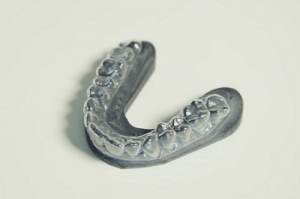 Swiss medical technology company nivellmedical AG is focused on developing, manufacturing, and distributing nivellipso, a novel clear aligner system for correcting misaligned teeth. The system, a more aesthetically pleasing alternative to the conventional fixed braces, uses biocompatible, invisible plastic splints that gently move teeth to the desired position. The company is using HP’s Multi Jet Fusion technology to make its dental aligners, which has helped improve its digital workflow.
Swiss medical technology company nivellmedical AG is focused on developing, manufacturing, and distributing nivellipso, a novel clear aligner system for correcting misaligned teeth. The system, a more aesthetically pleasing alternative to the conventional fixed braces, uses biocompatible, invisible plastic splints that gently move teeth to the desired position. The company is using HP’s Multi Jet Fusion technology to make its dental aligners, which has helped improve its digital workflow.
“We are putting our focus on precision and quality work,” said Dr. Milan Stojanovic, the head of the nivellmedical board. “3D printing technology has simplified a lot of the production of aligners.
The patient’s mouth is scanned, and the scan is then sent to the laboratory, where a model is 3D printed and used to properly fit the aligners before they are shipped out to the patient. Learn more about the process in the video below:
Depowdering a Metal 3D Print Build
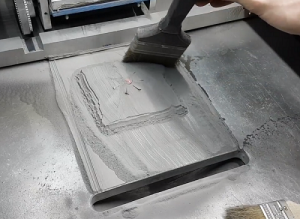 Have you ever seen those videos on the internet that are supposed to be ‘oddly satisfying’ and stress-reliving in a way you can’t quite figure out? The ones that show a ton of matches lighting up in a pattern, or someone slowly squishing their hands in a beautifully decorated pile of slime or some other weird material? Nick Drobchenko, a YouTube user from Saint Petersburg, has now introduced the 3D printing equivalent with his video of using a brush to slowly remove the metal powder from a 3D printed part.
Have you ever seen those videos on the internet that are supposed to be ‘oddly satisfying’ and stress-reliving in a way you can’t quite figure out? The ones that show a ton of matches lighting up in a pattern, or someone slowly squishing their hands in a beautifully decorated pile of slime or some other weird material? Nick Drobchenko, a YouTube user from Saint Petersburg, has now introduced the 3D printing equivalent with his video of using a brush to slowly remove the metal powder from a 3D printed part.
“Hollow stainless steel turbine, 90mm diameter. Printing time 4.5 hours,” Drobchenko wrote in the video description. “Printing cost $140, about 30 cm3.”
If the video below does not soothe and/or satisfy you, then I’m not sure what will:
Can a DLP 3D Printer Be Used for PCB Etching?
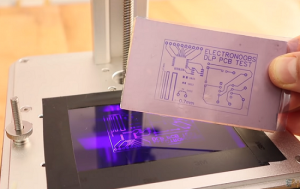 A maker named Andrei who goes by Electronoobs online recently acquired a couple of DLP 3D printers. After reviewing them, he wanted to see if it was possible to use DLP 3D printers to build the mask for PCB etching. So he created an experiment – with surprising results – and published a video about his experience on YouTube.
A maker named Andrei who goes by Electronoobs online recently acquired a couple of DLP 3D printers. After reviewing them, he wanted to see if it was possible to use DLP 3D printers to build the mask for PCB etching. So he created an experiment – with surprising results – and published a video about his experience on YouTube.
“I would only use the UV light of the printer to create the mask for the PCB, and then etch it using acid for copper PCBs just as always,” he explained in the video.
In addition to the DLP 3D printers, other things required for this experiment included copper boards, dry photosensitive film, sodium carbonate, latex gloves, and an iron. Spoiler alert – Electronoobs succeeds in using DLP technology to 3D print a mask for PCB etching. To see the rest of his impressive experiment, check out the video below:
3D Printed She-Ra Statue for New York Comic-Con
Utah-based 3D printing services company Whiteclouds has plenty of experience with the technology in many applications, from aerospace, gaming, and mapping to medical for both animals and humans. But recently, the employees got to participate in a project that was, as Whiteclouds CEO Jerry Ropelato told 3DPrint.com, “one of the coolest (and funnest) 3D prints” they’ve ever worked on. The company was asked to design and 3D print the statue of She-Ra at the recent New York Comic-Con.
“It was our tallest at 11 foot tall,” Ropelato told us.
DreamWorks and Netflix are bringing She-Ra and the Princesses of Power back to life with an animated series that will begin next month. According to a Facebook post by Ropelato, Whiteclouds enjoyed every bit of the Comic-Con project, which included designing and 3D printing She-Ra’s throne and sword. The team used touch-sensitivity electronics for activating the sound and lighting for the statue, and were proud to have a small part in the She-Ra reboot.
Discuss these stories and other 3D printing topics at 3DPrintBoard.com or share your thoughts in the comments below.

